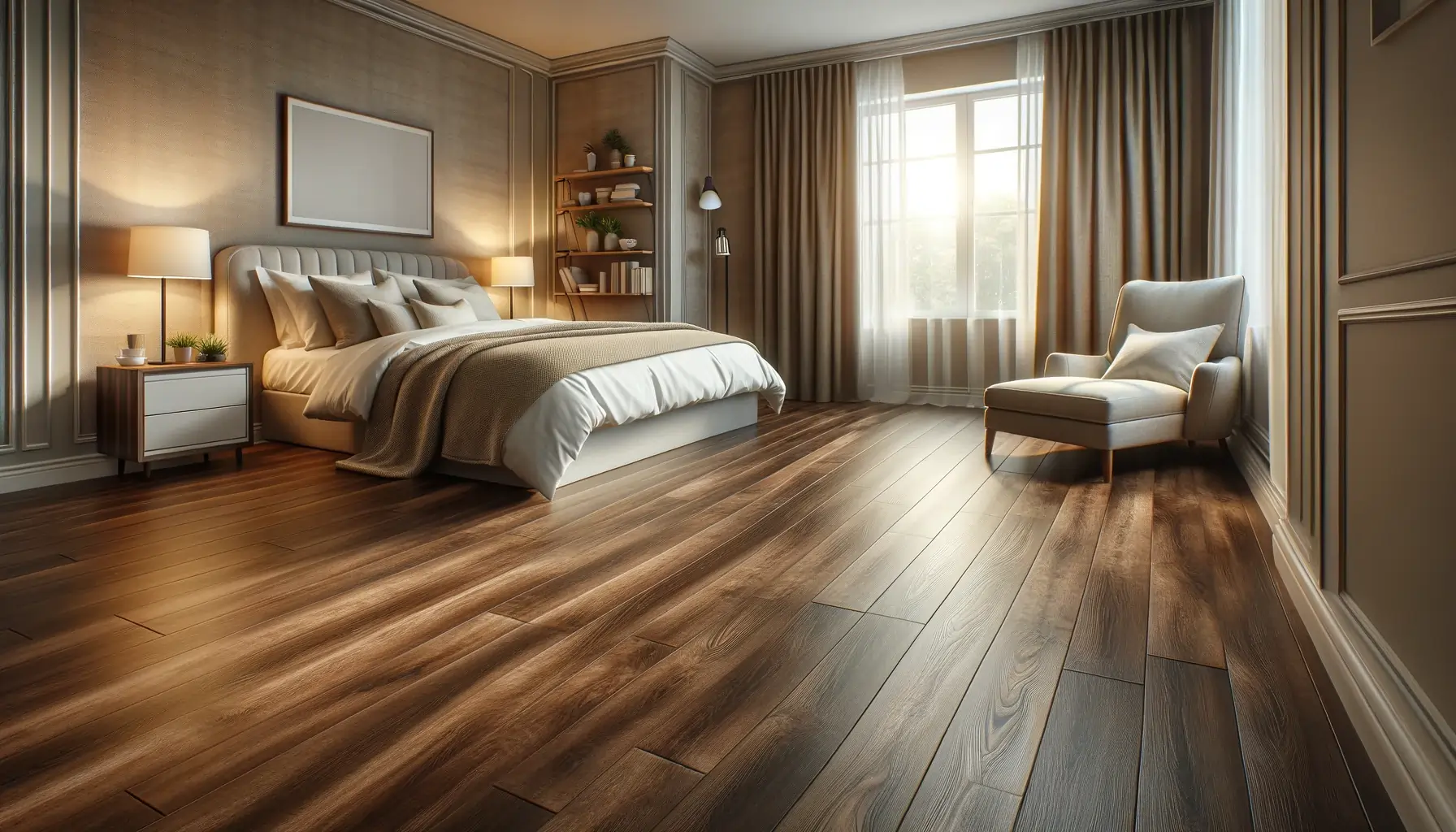Learn » Interior Design »
When it comes to choosing the right flooring for your home, vinyl is a popular option that offers durability, versatility, and affordability. With its wide range of styles and colors, vinyl flooring can mimic the look of natural materials like wood or stone, while providing a comfortable and low-maintenance solution. In this article, we will explore everything you need to know about vinyl flooring, including its types, pros, cons, installation process, and maintenance tips. So, let’s get started!
What is Vinyl Flooring and How Is It Made?
Vinyl flooring, a synthetic material made from polyvinyl chloride (PVC), is a versatile and cost-effective flooring option suitable for both residential and commercial use. Its manufacturing begins with PVC resin, derived from petroleum and natural gas, mixed with plasticizers, stabilizers, and pigments to enhance durability, flexibility, and color. During compounding, these components are heated and blended in industrial mixers to ensure a uniform composition. This step is critical for determining the vinyl flooring’s final characteristics like flexibility and wear resistance.
The calendaring phase involves rolling the mixture into thin sheets, which are then cooled and trimmed. The thickness varies based on the flooring’s intended use. Embossing follows, where the sheets pass through rollers to imprint patterns and textures, ranging from simple designs to realistic wood or tile imitations. A protective layer of urethane or acrylic is then added for scratch, stain, and fade resistance, also influencing the finish’s glossiness or matte appearance. Finally, the sheets are cut into tiles or planks, packaged, and distributed.
Here Are the Manufacturing Highlights:
- Composition: Made from PVC resin, mixed with additives for desired properties.
- Compounding: Heating and blending for uniformity and specific characteristics.
- Calendaring: Rolling mixture into sheets, followed by cooling and trimming.
- Embossing: Adding textures and patterns for aesthetic appeal.
- Protective Coating: Enhancing durability and determining finish.
- Final Processing: Cutting into tiles or planks for distribution.
Vinyl flooring’s manufacturing process combines chemical and mechanical processes with skilled craftsmanship, resulting in a durable, stylish, and easy-to-install flooring solution.
Read also – How to Draw a Floor Plan & Top Mistakes to Avoid
How Durable Is Vinyl Flooring?
Vinyl flooring stands out for its exceptional durability, making it ideal for high-traffic areas like kitchens and hallways. Its lifespan, ranging from 10 to 20 years, depends on factors such as the quality and thickness of the wear layer, a protective coating that guards against scratches, stains, and general wear. This clear PVC layer is crucial for preserving the floor’s integrity.
Delving Into Vinyl Flooring’s Durability:
- Wear Layer Composition: Made of clear PVC, it provides resistance to damage and protects the design layer.
- Resilience: Vinyl’s flexibility allows it to absorb impacts and resist dents, making it suitable for areas where heavy objects might be dropped.
- Moisture Resistance: Ideal for moist environments like bathrooms and basements, as it doesn’t absorb water, preventing swelling and mold growth.
- Maintenance Ease: Requires minimal upkeep, with regular sweeping, vacuuming, and occasional mopping.
- Pet and Child-Friendly: Can withstand spills and pet claws, maintaining its appearance in active households.
In conclusion, the durability of vinyl flooring is a result of its wear layer, resilience, moisture resistance, and ease of maintenance. These factors combined make vinyl flooring a reliable and long-lasting choice for various spaces in your home.
Read also – Underfloor Heating vs Radiators: A Buyer Guide
What Are the Advantages and Disadvantages of Vinyl Flooring?
Vinyl flooring, with its blend of aesthetics, durability, and ease of maintenance, is a favored choice for those seeking a versatile and affordable flooring solution. It replicates materials like wood and stone and is well-suited for all areas of the home due to its water-resistant properties. Its installation is DIY-friendly, and its robustness against traffic and scratches makes it suitable for homes with pets and children. However, vinyl flooring can get scratched by heavy objects, may fade under intense sunlight, and some types may emit VOCs, although there are low-VOC alternatives.
Here’s a table comparison of the advantages and disadvantages of vinyl flooring:
| Criteria | Advantages of Vinyl Flooring | Disadvantages of Vinyl Flooring |
|---|---|---|
| Style and Design | Wide variety of styles, mimics wood or stone. | Limited to the realism of print and texture techniques. |
| Water Resistance | Suitable for all rooms, including kitchens and baths. | Not completely waterproof in extreme conditions. |
| Installation | Easy, DIY-friendly. | Subfloor preparation is crucial for optimal results. |
| Durability | Resists heavy traffic and scratches. | Scratching possible from sharp/heavy objects. |
| Maintenance | Requires minimal upkeep. | Harsh cleaners can damage the surface. |
| Cost-Effectiveness | Can be installed over existing floors. | Initial cost varies based on quality and design. |
| Sunlight Reaction | Resistant to moderate exposure. | Discoloration with prolonged exposure to sunlight. |
| Chemical Emissions | Low VOC options available. | Some products may emit VOCs. |
How Do You Install Vinyl Flooring?
Installing vinyl flooring can be a rewarding DIY project or can be handled by professionals. The installation steps vary based on the type of vinyl flooring either Luxury Vinyl Plank (LVP) or Luxury Vinyl Tile (LVT), and the chosen installation method floating or glued-down. Here’s a step-by-step guide:
- Choose Your Vinyl Flooring Type:
- Decide between LVP (plank) or LVT (tile) based on your preference and the area of installation.
- Prepare the Subfloor:
- Ensure the subfloor is clean, dry, and level. Remove any debris, dust, or existing flooring.
- Level the subfloor if necessary, using a leveling compound to fill in low spots.
- Acclimate the Vinyl Flooring:
- Place the vinyl flooring in the room where it will be installed for at least 48 hours prior to installation to acclimate to the room’s temperature and humidity.
- Plan the Layout:
- Measure the room and plan the layout to minimize waste and ensure an aesthetically pleasing pattern.
- Consider the direction of the planks or tiles for the best visual impact.
- Cutting the Vinyl:
- Cut the vinyl planks or tiles to fit the room’s dimensions, using a utility knife or vinyl cutter.
- Installation Method:
- For Floating Floors: Interlock the vinyl planks or tiles and lay them directly on the subfloor. Start from a corner, working row by row.
- For Glued-Down Floors: Apply adhesive to the subfloor and lay the vinyl planks or tiles, pressing firmly to ensure good adhesion.
- Secure the Flooring:
- For floating floors, ensure that each piece is securely interlocked with its neighbors.
- For glued-down floors, use a roller to press the floor into the adhesive for a secure bond.
- Add Finishing Touches:
- Install baseboards or trim to cover the expansion gap around the room’s perimeter.
- Caulk around the edges if necessary to seal any gaps.
- Inspection & Post-Installation Care:
- Clean any adhesive residue and inspect the floor for any gaps or misalignments.
- Avoid heavy traffic on the flooring for at least 24 hours.
- Follow specific care and maintenance guidelines for vinyl flooring to ensure longevity.
This process, when followed carefully, ensures a smooth and durable installation of vinyl flooring, enhancing the appearance and functionality of your space.
How Foyr Neo Can Visualize Vinyl Flooring
Choosing the right flooring for your home is an important decision, and vinyl flooring offers an array of benefits that make it a popular choice among homeowners. Its durability, easy maintenance, and wide range of styles make it suitable for any room in your home. Whether you prefer the warmth of wood or the elegance of stone, vinyl flooring can provide you with a budget-friendly solution.
When considering vinyl flooring, it helps to visualize how it will look in your space. Foyr Neo is a powerful interior design software that allows you to virtually design and visualize your rooms with different flooring options. With its user-friendly interface and realistic rendering capabilities, Foyr Neo can help you make confident decisions and bring your vision to life.
So, if you’re ready to upgrade your floors and transform your home, consider vinyl flooring as a versatile and cost-effective solution. With Foyr Neo’s intuitive design interface and seamless collaboration features, you can design and visualize how vinyl flooring looks in your dream project. Join Foyr Neo’s 14 days free trial today and take your design practice to the next level!
FAQs
Laminate flooring, made of high-density fiberboard with a photographic layer, is durable and scratch-resistant but less water-resistant than vinyl. Vinyl, made of PVC, offers a wider range of styles and better moisture resistance, suitable for high-traffic and spill-prone areas. The choice depends on specific needs and preferences.
Regularly sweep or vacuum to remove dirt. Clean with a damp mop or microfiber cloth and mild detergent, avoiding excessive water and abrasive cleaners. Place mats in high-traffic areas and promptly wipe up spills.
Yes, vinyl flooring has excellent waterproof properties, making it suitable for areas like bathrooms and kitchens. However, it’s important to note that while the surface is waterproof, moisture can seep between seams.
The lifespan of vinyl flooring ranges from 10 to 20 years, influenced by quality, thickness, and maintenance. Choosing high-quality vinyl and following proper care extends its longevity.
Vinyl flooring is versatile enough for almost any room, including moisture-prone areas like bathrooms. However, it’s not recommended for outdoor use or in areas with prolonged direct sunlight exposure.










